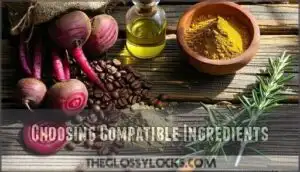This site is supported by our readers. We may earn a commission, at no cost to you, if you purchase through links.

Coffee grounds create rich brown tones, while henna delivers lasting reddish hues.
Black tea darkens lighter beards gradually, and beetroot juice adds subtle reddish tints.
Mix your chosen ingredient with water to form a paste, apply evenly through clean beard hair, and let it sit for 30-60 minutes before rinsing.
These natural methods take patience since results build gradually over multiple applications.
Your beard gets nourishment while achieving color, making it a win-win situation.
The key lies in understanding which ingredients work best for your specific beard color and desired outcome, using simple kitchen ingredients.
Table Of Contents
- Key Takeaways
- Natural Beard Dye Benefits
- Choosing Natural Dyes
- Applying Natural Dyes
- Natural Dye Expectations
- Dyeing Safety Precautions
- Frequently Asked Questions (FAQs)
- How can I naturally darken my beard?
- How can I color my beard without skin coloring?
- Is there a safe way to dye your beard?
- How long do natural beard dyes last?
- Can natural dyes cover completely gray beards?
- Whats the cost comparison to commercial dyes?
- Do natural dyes work on all beard textures?
- How often should I reapply natural dyes?
- Conclusion
Key Takeaways
- You can create effective natural beard dyes using simple kitchen ingredients like coffee grounds for brown tones, henna for reddish hues, black tea for gradual darkening, and beetroot juice for subtle red tints.
- You’ll need patience since natural dyes work gradually over multiple applications, typically requiring reapplication every 3-6 weeks to maintain color, but they nourish your beard while coloring it.
- You should always perform a patch test 24 hours before full application and use petroleum jelly around your beard area to protect your skin from staining during the dyeing process.
- You’ll get the best results by setting realistic expectations—natural dyes provide subtle, temporary changes that work best for enhancing your existing color or covering minor grays rather than dramatic transformations.
Natural Beard Dye Benefits
You’ll protect your skin and beard hair from harsh chemicals like ammonia and peroxide when you choose natural dyes made from plant-based ingredients.
Switch to nature’s gentle touch and give your beard the chemical-free makeover it deserves.
These organic options color your facial hair and also nourish it, making your beard healthier while reducing the risk of irritation and allergic reactions, which is a key benefit of using natural dyes.
Organic Ingredients Used
Natural beard dye ingredients come straight from Mother Nature’s pantry.
You’ll find powerful coloring agents in everyday items that deliver impressive results without synthetic additives.
Here are the top organic ingredients for DIY beard dye:
- Henna benefits include rich reddish-brown tones and hair conditioning properties
- Coffee effects create subtle darkening with natural caffeine-based pigments
- Beetroot color provides vibrant burgundy shades from pure vegetable extract
Minimizing Irritation Risks
Beyond choosing organic ingredients, you’ll want to protect your skin from potential reactions.
Patch testing becomes your safety net when trying any natural beard dye. Apply a small amount behind your ear 24 hours before full application to check for ingredient sensitivity.
| Risk Factor | Prevention Method |
|---|---|
| Allergic reactions | Conduct patch testing first |
| Skin irritation | Use skin barrier cream around beard |
| Chemical burns | Choose gentle application methods |
Nourishing Beard Hair
Unlike chemical alternatives, natural beard dye actually feeds your facial hair while coloring it.
Transform your beard while you nourish it—natural dyes deliver color and care in one powerful step.
These natural ingredients deliver essential nutrients that promote healthy growth and damage prevention.
You’ll notice improved softness enhancement as natural oils condition each strand.
This dual-action approach means you’re not just changing color—you’re investing in long-term beard hair health through proper hydration importance and nourishment, which also enhances softness.
Avoiding Chemicals
Commercial beard dyes expose you to harsh chemicals like ammonia and peroxide that can trigger chemical sensitivity and skin reactions.
When you choose natural beard dye alternatives, you’re embracing toxin reduction for safer beards.
DIY beard color using homemade beard dye ingredients offers natural advantages over synthetic alternatives.
You’ll avoid irritating compounds while achieving effective natural beard tint results without chemicals.
Sustainable Options
Your homemade beard dye choices pack an environmental punch beyond personal benefits.
Natural ingredients like henna and coffee offer eco-friendly sourcing with minimal carbon footprint. You’re reducing waste by skipping commercial products with biodegradable packaging concerns.
DIY beard color using kitchen staples supports ethical considerations while delivering chemical-free results. It’s sustainable grooming that actually works for you and the planet.
Some individuals also opt for herbal hair options for their beards.
Choosing Natural Dyes
You’ll find several natural dye options that work effectively for coloring your beard at home, each offering unique color results and benefits.
The key is selecting the right natural ingredient based on your current beard color and the shade you want to achieve.
Beetroot Dye Options
Beetroot delivers a stunning burgundy hue that’s perfect for your herbal beard dye goals.
This natural beard dye option offers excellent color depth while maintaining gentle dye consistency throughout the application process. The method leverages natural dyeing methods for a vibrant color.
Here’s your complete beetroot color guide:
- Extract fresh beet juice using a juicer or blender for maximum pigment concentration
- Mix your beard dye recipe with carrier oil to prevent dripping during application
- Apply evenly and let the dye beard without chemicals process work for one hour
- Rinse thoroughly with cool water to lock in color
- Follow aftercare tips including beard oil application for superior results
Carrot Juice Dye Results
Carrot juice delivers a vibrant reddish-orange beard color that’s perfect for covering white hairs naturally.
You’ll get the best orange tint intensity by mixing fresh carrot juice with carrier oil options like coconut or olive oil. Carrot juice contains beta carotene, which may promote overall hair health.
Apply this natural beard dye every 3-4 weeks, then follow with a vinegar rinse for enhanced color retention.
| Factor | Details |
|---|---|
| Orange Tint Intensity | Moderate to vibrant depending on original hair color |
| White Hair Coverage | Excellent coverage for gray and white strands |
| Application Frequency | Every 3-4 weeks for maintained color |
| Carrier Oil Options | Coconut, olive, or jojoba oil work best |
Henna Dye Benefits
Henna stands out as the gold standard for natural beard dye benefits.
This traditional use ingredient delivers exceptional henna nourishment while providing rich natural pigmentation.
Unlike synthetic options, henna beard dye offers superior conditioning effects as a true chemical alternative.
You’ll get lasting color plus healthier facial hair, making this natural ingredients choice perfect for men wanting effective, gentle results with natural ingredients.
Coffee Dye Effects
Coffee-powered transformations deliver impressive results for beard coloring enthusiasts.
This natural beard dye method uses coffee’s rich pigments to darken white hairs while nourishing facial hair. Coffee dye longevity spans several weeks with proper application. The process offers a temporary darker hair color, washing out after a few shampoos.
Here’s what makes coffee beard dye exceptional:
- Deep brown shades that complement most skin tones naturally
- Antioxidant-rich formula that fights aging signs in facial hair
- Caffeine stimulation promoting healthier hair follicle growth
- Chemical-free darkening without harsh synthetic ingredients
- Cost-effective solution using common household coffee supplies
Cinnamon Dye Results
With its warm properties, cinnamon creates a subtle reddish tinge that works best on black hair.
This natural ingredient can lighten beard hair gradually through consistent use, and application frequency matters for visible results.
Among natural beard dye recipes, cinnamon stands out in natural beard dye methods as one of the gentlest natural ingredients for DIY recipe enthusiasts, and don’t expect dramatic transformation—the expected shade remains understated.
Applying Natural Dyes
Once you’ve selected your natural dye, proper application guarantees even coverage and superior color results.
You’ll need to mix your ingredients thoroughly, apply the mixture evenly with a brush, and follow specific timing guidelines for each dye type.
Preparation Methods
Before diving into natural beard dye recipes, proper preparation sets you up for success.
Wait until your beard length reaches at least one inch for effective dye absorption. Focus on shade selection that complements your natural color rather than dramatic changes.
Always perform patch testing with your chosen natural ingredients first. Using a natural beard wash is essential for superior results.
Thoroughly wash your beard without conditioner, as clean hair accepts DIY recipe applications better than product-laden facial hair.
Application Techniques
Now that you’ve mixed your natural dye, proper application makes all the difference.
Use a small brush for precise beard dye application, starting from roots and working outward.
Maintain consistent dye consistency throughout the DIY grooming process.
For superior results, consider using a specialized applicator brush.
Focus on even distribution by sectioning your beard into manageable parts.
This systematic beard dyeing process guarantees complete coverage and professional-looking results every time.
Recommended Setting Times
Once you’ve applied your natural dye using proper techniques, timing becomes everything.
Most natural beard dyes need 15-30 minutes for maximum color intensity, though this varies based on hair porosity and your desired shade.
Here’s your dye setting guide:
- Lighter coloured beards: 10-15 minutes for subtle changes
- Dark beards: 20-30 minutes for noticeable results
- Temperature effects: Warm environments speed up dye oxidation
Monitor your usual routine timing carefully.
Washing and Rinsing
After the setting time, rinse your beard thoroughly with lukewarm water to remove all dye residue.
Use a gentle shampoo to guarantee complete beard cleaning, focusing on residue removal from hair follicles.
Avoid hot water as it can strip natural oils.
Pat dry with a clean towel using gentle drying methods, then allow air-drying to complete the post-dye care process.
Maintenance Tips
After washing, your beard maintenance routine determines how long your natural dye lasts. Color protection starts with reducing shampoo frequency to twice weekly.
Natural beard oil helps moisturize and prevents colour fading. Your reapplication schedule depends on growth rate, but plan for root touch-ups every three weeks. Minimize handling to avoid rubbing off pigment.
- Reduce beard washing frequency – Overwashing strips natural oils and accelerates color fading, so limit shampooing to preserve your dye job longer
- Apply natural beard oil daily – Moisturizing with organic oils keeps facial hair healthy while creating a protective barrier that helps maintain color intensity
- Schedule regular root touch-ups – Fast-growing facial hair shows new growth quickly, so plan maintenance sessions every 3-4 weeks for consistent coverage
Natural Dye Expectations
When using natural dyes for your beard, it’s important to set realistic expectations.
These methods provide subtle, temporary changes and work best for enhancing your natural color or covering minor grays.
Temporary Results
Natural beard dyes like beet juice, carrot juice, coffee, and cinnamon deliver temporary beard color that gradually fades over weeks.
You’ll need regular application frequency for shade maintenance, typically every 3-6 weeks.
Color fading happens naturally as you wash and style your beard, and root touch-ups become necessary more often due to fast facial hair growth requiring gradual changes through consistent reapplication of natural dyes.
Dependent on Original Color
Your beard’s starting color determines what natural beard dye alternatives can achieve.
Color limitations mean you can’t transform a jet-black beard into blonde using beetroot or henna.
Shade expectations should be realistic – darker beards show minimal changes, while lighter ones reveal natural undertones beautifully.
Gradual changes work best when your chosen dye complements your existing beard darkness naturally and achieves the desired effect with minimal changes.
Nourishing Effects
Unlike chemical dyes that strip moisture, natural alternatives actually boost hair health while coloring.
You’re feeding your facial hair essential nutrients that promote growth promotion and natural shine.
These gentle formulas provide skin hydration around follicles, creating ideal conditions for healthy beard development.
Think of natural beard dye alternatives as moisturizing treatments that happen to add color—your beard gets stronger with each application.
Consider using natural hair dyes options for a safer approach to achieve a healthy and strong beard, which is a result of natural shine.
Suitable for Sensitive Skin
If you’ve got sensitive skin, natural beard dye becomes your best friend.
These gentle ingredients won’t leave your face looking like an angry tomato after application.
Here’s why sensitive skin loves natural dyes:
- Allergy prevention – Plant-based formulas reduce reactions compared to harsh chemicals
- Reduced irritation – No ammonia or peroxide means less burning and stinging
- Skin compatibility – Always do patch testing first for safe beard dye results
Limitations and Considerations
Patience becomes your biggest ally when using natural beard dyes.
Color fading happens faster than commercial options, and gray coverage won’t match chemical alternatives.
You’ll need frequent reapplication every 3-4 weeks to maintain results.
| Natural Beard Dye Drawbacks | Effectiveness Level | Application Frequency |
|---|---|---|
| Limited color intensity on dark beards | Moderate gray coverage | Every 3-4 weeks |
| Faster color fading than chemicals | Best for subtle changes | Touch-ups needed |
| Potential allergic reactions/skin irritation | Gradual results over time | Multiple sessions required |
The key to successful use of these dyes is understanding their limited color intensity and planning for frequent reapplication.
This approach allows for gradual results and helps in managing the drawbacks associated with natural beard dyes.
Dyeing Safety Precautions
Before you apply any natural dye to your beard, you’ll need to take proper safety steps to protect your skin and guarantee the best results.
Always perform a patch test on a small area of skin 24 hours before dyeing.
Use petroleum jelly around your beard area to prevent staining your face.
Choosing Compatible Ingredients
Your skin sensitivity determines which natural beard dye ingredients you’ll tolerate best.
Before mixing henna, coffee, or beet juice, conduct allergy testing on a small skin patch.
Consider ingredient interactions when combining organic beard dye elements—some plantbased dyes react differently together.
Match homemade hair dye recipes to your desired undertones, as natural pigments vary in strength and compatibility with individual skin types, and note the importance of allergy testing.
Protecting Surrounding Skin
Before applying any beard dye, create a protective barrier around your facial skin.
Apply petroleum jelly or barrier creams along your hairline, cheeks, and neck to prevent staining.
Always wear protective gloves during application and make certain your application tools are clean.
This simple step prevents skin irritation and makes cleanup easier, especially for sensitive skin prone to allergic reactions.
For superior results, remember to comb your beard before applying dye, and ensure you have a clean application process.
Cleaning and Preparation
Clean preparation sets the foundation for successful natural beard dye application. Start with a thorough shampoo to remove oils and buildup, but avoid conditioner as it blocks dye absorption.
For superior beard health, consider using natural beard wash. Ensure your beard length is at least one inch for even coverage.
Complete patch testing 24 hours beforehand. Use clean mixing bowls and application tools to prevent contamination and guarantee the best results.
Customization and Layering Techniques
Through strategic ingredient ratios, you’ll discover remarkable color blending possibilities with natural beard dye.
Mix henna with indigo for deeper tones, or combine coffee with herbal extracts for unique variations.
Layering intensity builds gradually—apply one natural color, let it set, then add another for enhanced tone depth.
This customization approach delivers personalized results while maintaining your beard’s health and natural appearance.
Frequently Asked Questions (FAQs)
How can I naturally darken my beard?
Coffee will absolutely revolutionize your beard game! Mix strong coffee grounds with water, apply to clean facial hair for one hour, then rinse. Repeat weekly for gradual, natural darkening results.
How can I color my beard without skin coloring?
You’ll want to protect your skin with petroleum jelly around your beard’s edges before applying natural dyes.
This creates a barrier that prevents henna, coffee, or other dyes from staining your facial skin.
Is there a safe way to dye your beard?
Seventy percent of men experience beard irritation from commercial dyes.
You can safely dye your beard using natural ingredients like henna, coffee, or beet juice, which nourish hair while coloring without harsh chemicals.
How long do natural beard dyes last?
Natural beard dyes typically last 3-6 weeks before fading.
You’ll need to reapply them regularly since they’re semi-permanent.
Touch-ups every few weeks help maintain your desired color as facial hair grows quickly.
Can natural dyes cover completely gray beards?
Take John, whose salt-and-pepper beard transformed beautifully with henna treatments.
Yes, you can cover completely gray beards using natural dyes, though it’ll require multiple applications and patience for full coverage and lasting results.
Whats the cost comparison to commercial dyes?
Budget-friendly natural ingredients like coffee, henna, and beet juice cost $2-8 compared to commercial dyes at $15- You’ll save money long-term, though you’ll need more frequent applications to maintain color.
Do natural dyes work on all beard textures?
Coarse textures, fine strands, curly patterns—natural dyes adapt to all beard types, though results vary.
Your thick beard absorbs color differently than thin hair, requiring adjusted application times and ingredient concentrations for maximum coverage.
How often should I reapply natural dyes?
You’ll need to reapply natural dyes every 3-6 weeks to maintain your desired color.
Touch up roots more frequently since facial hair grows fast.
Reduce shampooing to once weekly for longer-lasting results.
Conclusion
Tom switched from chemical beard dyes to coffee grounds after experiencing skin irritation.
Within three weeks, his beard developed rich brown tones while becoming softer and healthier.
When you dye beard naturally at home, you’re choosing a gentle approach that nourishes rather than damages.
These kitchen ingredients won’t deliver instant results like commercial products, but they’ll gradually transform your beard color while keeping your skin comfortable.
Start with one method and adjust based on your results, using natural ingredients and a gradual process to achieve the desired effect.
- https://hair-everyday.com/blogs/hair-care/how-to-color-beard-at-home
- https://support.ecitizen.go.ke/how-to-color-your-beard-naturally-5-best-diy-methods/
- https://www.beardofhis.com/how-to-dye-your-beard-naturally/
- https://www.discoverynaturals.com/blog/organic-beard-color-and-dye-guide
- https://satthwa.com/blogs/beard-care/how-to-dye-your-beard-the-natural-way














